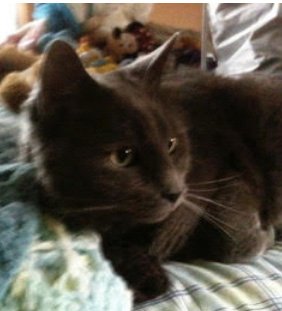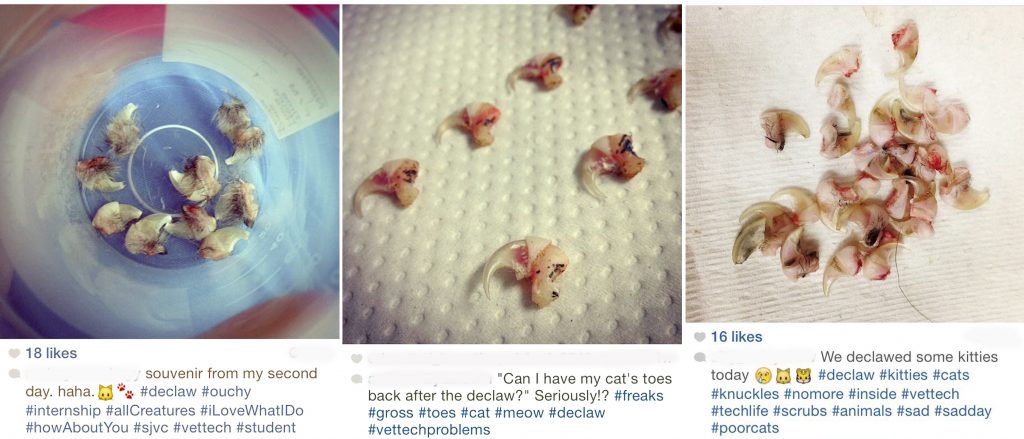Alternative Declawing Facts By Two Prominent New Jersey Vets

Dr Jose Pla is the vet who does their declaws. They advertise their laser declaws on their facebook pages, their employees say that Dr Pla performs declaws, “all the time”, ” Dr Beeber says that a cat will be ok from being declawed, they post photos of declawed cats and promote their laser declaw, and they charge $875 for their laser declaws and will even do them on older cats.
My Veterinarian Accidentally Declawed My Cat

He was a fun and spunky kitten. At seven months old, I was able to get a voucher for a reduced cost neuter. I took him to the vet to have the procedure done. They let me know that I could pick him up at the end of the day. I had a sense of dread all day and when I didn’t hear from them, I called to make sure I could come pick him up. They informed me that he had his first procedure and was doing well and his neuter was scheduled for later. I was confused and asked what she was talking about.
When she said his front paws were declawed, I lost it. I was so angry and upset that I don’t remember what I said. That anger grew when she said “Sorry. We mistook him for another cat.”
A True Advocate For All Animals

I have been a veterinarian for 20 years, 16 of which have been in 100% feline practice, and I have never had anyone threaten to euthanize or relinquish their cat because of clawing behavior. The behavior problems that I have seen result in euthanasia or abandonment are inappropriate elimination and biting, which I see far more often in declawed than clawed cats.
I have always been adamantly opposed to declawing and have found that if I simply tell people that it requires amputating the last bone on every toe, the vast majority of clients do not want to do it. Most people really do love their cats, and they don’t want to hurt them, but they haven’t been informed about the procedure.
I always counsel people about having appropriate scratching posts, trimming nails, and using Soft Paws. It does require some effort, but so do most things worth having in life.
Beware, the Banality of Evil

Beware, the banality of evil.
Some old time vets will hang on to the past, using antiquated techniques and medications, because that’s what “they were taught.” They don’t question what is “normal.” Other vets are more innovative and want veterinary medicine to be as progressive as human medicine. State of the art medicine and diagnostics can really help save lives. These vets are willing to learn new, life-saving techniques and medications and therefore eschew the old, the less effective or inhumane.
Purina & Declawing Veterinarians – A Mutually Beneficial Relationship

Here are examples of how pro-declaw vets and Purina have a mutually beneficial relationship and how they are profiting from this very inhumane and cruel procedure.
When you know better, you do better

My family became educated on declawing and we made the relationship between the kitties work without having to declaw another cat.
One Giant Step For Catkind That All Veterinary Practices Should Take

We used to believe that declawing cats saved their lives. We feared that cats with claws would be turned in to the shelters in record numbers, and that we were doing a good thing by making cats more likely to stay in their homes.
As it turns out, the numbers do not bear this out. When areas have stopped declawing, the number of surrendered cats actually dropped. This left us with a question. We know that even under the best of circumstances, a declaw is a major and painful surgery, (and no less so when it is performed with a laser, by the way.) It is an amputation of the end of the cat’s “finger,” not just the removal of the claw itself. And even when performed perfectly, can have life-long complications.
So we wondered, if we weren’t saving cats, and this procedure can be painful to cats, why were we doing this? Although we know furniture destruction can be a problem, it can almost always be prevented with the right techniques. Besides, when it comes down to it, as veterinarians, our main concern is the cats, not the couches. We have to do what is best for our patients.
Dixie, The 4 Paw Declawed Cat That Was Saved From Being Euthanized

Here is an update about Dixie the kitty who was relinquished by her owners to Tails Humane Society because of behavioral issues from her four paw declaw and was to be euthanized yesterday. Good news!!! She has a second chance in life!
Tails Humane Society said that Dixie is not going to be euthanized! She has to recover from a bad upper respiratory infection and needs dental work before she can be taken out of this shelter.
There are two rescues who want to get her out of the shelter and into a good home.
Amputating 10 Cat Toes Is No More Painful Than A Neuter – NJVMA SpokesVet

When cats start walking on their balls then we will start believing the NJVMA’s spokesvet Dr Yurkus and his animal hospital that declawing isn’t more painful than neutering.
Meanwhile, the American Association of Feline Practitioners’ policy on declawing states:
“Physically, regardless of the method used, onychectomy causes a higher level of pain than spays and neuters. Patients may experience both adaptive and maladaptive pain; in addition to inflammatory pain, there is the potential to develop long-term neuropathic or central pain if the pain is inadequately managed during the perioperative and healing periods.” [AAFP Policy Statement on Declawing, 2007.]
The Painful Truth About Declawing

To put these all this in perspective, there are, more or less, 80 million pet cats in the U.S. At least 20% are declawed (estimates range from 20-45%), which is 16,000,000 cats. If even only 5% have long-term painful complications (and the number is likely far higher), that’s still 800,000 cats with known chronic pain, obvious pain.
How many is too many to suffer?
Clearly, veterinarians as a profession have failed to keep up with modern medicine, failed to govern themselves, and failed to understand the universal, serious, and potentially lifetime pain they are causing cats by declawing. Sadly, there is no mechanism to enforce changes in the profession.
Therefore, legislation is necessary to stop the cruel and unnecessary practice of declawing.
